A little bit about yoga and yantras
Yoga originated from Lord Shiva. Lord Shiva is the Lord of mercy and compassion.
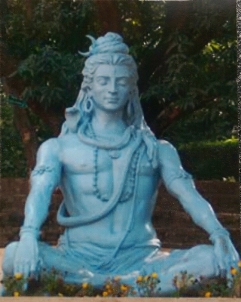
"He is fire and the sun, and the moon and the stars. He is the air and the sea, and the Creator, Prajapati. He is this boy, He is that girl, He is this man, He is that woman, and He is this old man, too, totering on his staff. His face is everywhere." (Shvetashvatara Upanishad iv 2,3)
Shiva is also love and therefore he manifests in creation an energy (anugrahashakti) which drives on the human beings on their path of development. Anugrahashakti means: energy (Shakti) that grasps (graha) the individual human being (anu). At a certain point in his development, in the human being a desire for spiritual development arises. Mostly he orientates himself by reading spiritual books, by looking for a teacher, by practising yoga, by practising meditation, etcetera. Nisargadatta, a famous realized teacher, living in Bombay in the 20th century described for his students the working of anugrahashakti as follows: "By His (Shiva's) grace your mind is engaged in finding the truth, and by His grace you will find it". So the best translation for anugrahashakti is probably the energy of divine revelation from Lord Shiva.

Shiva Lingam represents The Formless Shiva. Lingam is the outward symbol of the formless being of Lord Shiva, who is the indivisible, all-pervading, eternal, auspicious, immortal essence of this vast universe, who is the undying soul in our hearts.
Narmada Shiva Lingam (Bana Lingam) is the most sacred symbol and instrument of Divine energy in the ancient and the modern world; it has the highest frequency of vibration (compared with any other stones on Earth). The Sacred Narmada River is one of the Sapta Gangas - Seven Holy Rivers of India.The Hindustani Legends identify it with Reva of epic celebrity, which is described as the "sweat" flowing out of Lord Shiva's own body when he performed his Cosmic Dance Tandava and therefore considered as holiest of rivers. Many Vedic Scriptures propound that the natural Narmada Bana Lingas are self-manifest respresentations of Lord Shiva.
The Shiva Lingas that are formed in the River Narmada contain Crypto Crystalline Quartz (masses made up of either fibrous or granular aggregates of tiny, microscopic Quartz Crystals) and a Gemstone material called Chalcedony (with an iron oxide and geothite inclusion) alongwith Basalt and Agate - this unique composition coupled with elliptical shape has a precise resonance in alignment with our Energy Centers or Chakras and are used for thousands of years as Divine Energy Generators for Cleansing, Healing and for Meditation. The Narmada Bana Lingas are quite strong and the hardness is a 7 on the Mohs Scale. Each Bana Lingam is unique with its own markings. The colour of the stone varies a lot, from grey to beige, to brown and a reddish brown. They may be honey coloured, white, blue, black or emerald-hued.
According the considered view of many researchers and geologists that the unique composition of the Narmadha Shiva Lingas was due to the impregnation of it's rocky river-sides and the rocks in the river bed, 14 million years ago by a large meteorite that crashed into the Narmada River. The fusion of the Meteorite and the Earthly Minerals has spawned a new and unique type of Crystalline Rock with extraordinary energetic qualities - the Narmada Bana Lingam.
The Narmada Bana Lingam's upright egg shape represents the Pure Consciousness of Lord Shiva and the Holy Markings on the Sacred Stone (which differ greatly from stone to stone) represent the interactive aspect of Goddess Shakti (The Holy Consort of Lord Shiva), the Divine Seed which is fertilized to manifest the Creative Power in the Dance of the Cosmos. Together, they represent the Union of the Supreme Male and Supreme Female Energies - Shiva and Shakti : Shiva Shakti, the Wholeness and Oneness. It should also be understood that the Narmada Shiva Lingam represents the Divine Blending of Knowledge (Shiva) and Wisdom (Shakti). The Sacred Shiva Lingam is widely considered to be the "Form of the Formless". According to Vedic Texts, the Narmada Shiva Lingas illustrate Harmony through Duality and represent Power, Creation and the Physical Plane or Grounding of those who have these Divine Energy Tools.
The Narmada Bana Lingas are highly communicative gemstones, each with its own individual personality, purpose and reason for being. It is believed that there is a Bana Linga destined for each one of us and that the Bana Linga will find it's way to us when the time is right and when we are ready to receive it into our lives.
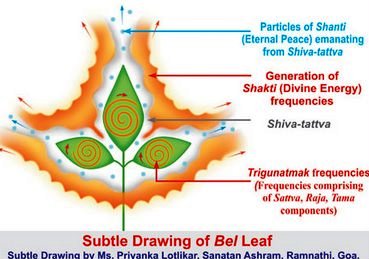
The Bilva Tree - The Divine Embodiment of Lord Shiva. According to the Shiva Purana (7 AD) the Bilva tree (commonly known as: Aegle marmelos, bael, Bengal-quince, golden-apple, stone apple, wood apple) is the manifest form of Lord Shiva himself, while all the great tirthas (pilgrimage places) are said to reside at its base. One who worships the Shivalingam while sitting under the Bilva, claims this great epic, attains the state of Shiva. Washing the head by this tree is said to be the equivalent of bathing in all the sacred rivers. One who performs Bilva pooja with flowers and incense achieves Shiva loka, the abode of pure consciousness, and has happiness and prosperity bestowed upon them.
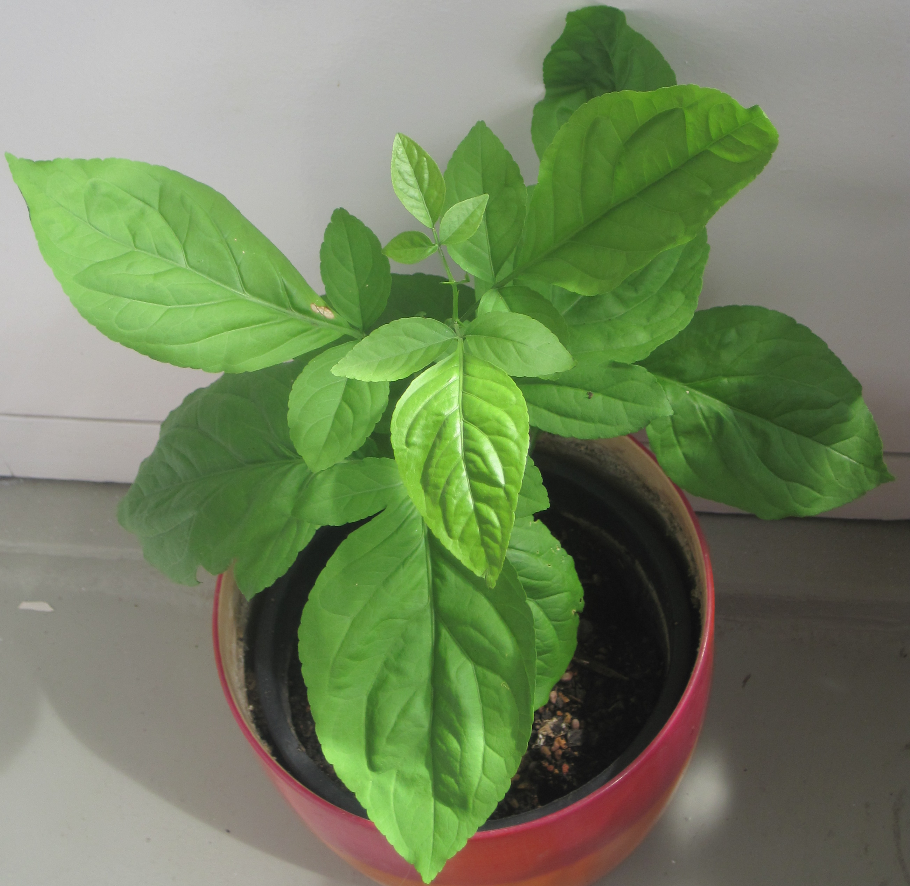
"Born from the breasts of Goddess Lakshmi, the Bilva tree is ever dear to Mahadeva. So I ask this tree to offer a Bilva leaf to Lord Shiva. To have darshan of the Bilva tree, and to touch it, frees one from sin. The most terrible karma is destroyed when a Bilva leaf is offered to Lord Shiva". Sri Bilva Shtakam (v. 6 - 7)
The Holy Rudraksha Beads. Rudraksha (Elaeocarpus ganitrus roxb) has its etymological origin in the Sanskrit words, Rudra and Aksha. Rudra is another name for Lord Shiva (the meaning of the name Rudra is traceable to the Vedas and said to be derived from rud (dravayita) he who drives away sin or suffering), and aksha means teardrop.
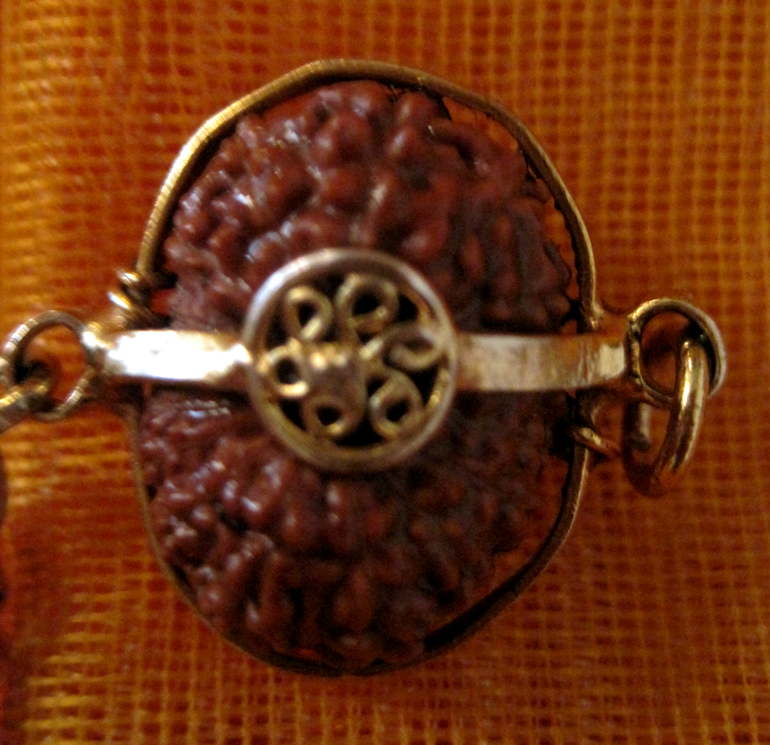
Rudraksha beads are classified on the basis of the number of mukhis - the clefts and furrows - they have on the surface. Each bead has a different effect, depending on the number of mukhis it has. These are vital from the astrological viewpoint, since it is believed that Rudrakshas of different mukhis please different planets. The scriptures speak of 1 to 38 mukhis.
According the Shiva Purana to Lord Shiva should be worshipped with Tripundra (the three horizontal stripes of holy ash applied to the forehead by worshippers of Lord Shiva. These stripes symbolise spiritual knowledge, purity and penance (spiritual practice of Yoga), so also they represent the three eyes of Lord Shiva), Rudraksha and Bilva.
Yoga Philosophy and Tradition
Yoga is an ancient Sanscrit word that means "union" or "oneness" of mind, body, spirit and mystery. Yoga also defines the relationship we have as a micro cosmos with the macro cosmos of the universe and this connection can be equated to the English "yoke" meaning harnessing or joining.
The word yoga means not the postures (asanas) popular in the West today, but also incorporates meditation, pranayama, self and social discipline of the senses and concentration of mind. According to Patanjali (the propounder of Ashtanga yoga) yoga is the cessation of all the sense organs in order to achieve enlightenment. A male yoga practitioner is called a yogi and a female a yogini.
When the world was created, Lord Shiva came onto the earth and through meditation passed on the knowledge of all yogic practices to seers e.g. Viswamitra (a highly advanced yogi), Kapila (who propounded Sankhya yoga) and Vashitha (who wrote the text Yoga Vashitha). For many years, the tradition of yoga was never fully recorded, simply passed on to others by oral tradition or through the meditation of the Rishis. Patanjali was the first Rishi to document all aspects of yoga, which occurred around 200 BCE. Patanjali yoga is still practiced to this day.
Later Lord Shiva realized that although Patanjali yoga was complete in itself and covered all aspects of human life and its relationships with others, including all living beings and the environment, a form of yoga that was more accessible and comprehensive to most people whatever their physical and mental ability was needed. So he developed another type of yoga, Hatha yoga. Lord Shiva again passed this on through meditation to Yogi Swatmaram, who wrote all this received knowledge into a book, Hatha Yoga Pradipika. This form is widely practiced today. Other yogis (teachers) received knowledge of various aspects of yoga through Lord Shiva and their gurus, two of which were Yogi Gorakshanath (who wrote the text Gorakshasamhita) and Yogi Gheranda (the author of Gheranda Samhita). Yogi Matsyendranath was also a disciple of Lord Shiva, but left no writings behind. He verbally passed on his knowledge of yoga to his students, one of from was Yogi Gorakshanath. Information about yoga was also partially documented in the Vedic texts, which are holy books that were propounded by the god of creation, Brahma, after receiving divine inspiration.
Yantras FAQs
Yantra literally means "Loom", "Instrument or Machine". In actual practice a Yantra is a symbolic representation of aspects of divinity, usually the Mother Goddess. It is an interlocking matrix of geometric figures, circles, triangles and floral patterns that form fractal patterns of elegance and beauty. Though drawn in two dimensions, a Yantra is supposed to represent a three dimensional sacred object. Three-dimensional Yantras are now becoming increasingly common.
Although the Yantra is primarily a meditation tool both for serious spiritual seekers as well as sculptors in the classical tradition, its Shakti is also available to new seekers with sincere devotion and good intention. Before creating Yantric artefacts in wood, stone or metal, they draw a Yantra that represents attributes of the god or goddess they wish to sculpt, etch or create. Intense meditation upon it causes the fully formed image to leap into the mind's eye with remarkable intensity with imprinting ability. In some cases, traditional Yantra-makers do not need to make a sketch before creating the image.
Yantras are also used for innumerable mundane purposes such as to enhance the quality of one's life, attract prosperity, abundance, love, harmony, peace, enhance learning, promote healing, relieve health problems, for career advancement, achieve desired goals in projects, improve business and protection from negative forces.
Abstract geometric representations of the universe that do not represent a deity, are called Mandalas. Every Yantra is a also a Mandala, though not all Mandalas are Yantras.
Yantras are constructed with observing immutable laws of sacred geometry, being symbolic representations of energy patterns of a deity and rank amongst the most powerful 'centering' devices for harnessing divine energies. The Yantra is actually more powerful than a picture of a God which, to be energized, requires a Yantra to be affixed at its base or back.
A Yantra always contains a Mantra associated with it. Just as the mind is a part of, yet different from the body, so is the Mantra from the Yantra. The Mantra is the mind consciousness while the Yantra is the form of the deity.
Maha Mrityunjaya Yantra
Lord Shiva is the vanquisher of death (Mrityunjaya). On worshipping Maha(great) Mrityunjaya one can escape from the miseries and troubles of this materialistic world as well as the problems related to inner soul. He eats our problems, tensions, stress, as well as our ego. This Yantra is used to free the fear of death, grave dangers, and fatal diseases and makes one courageous and healthy. It bestows the person with wealth, health, happiness, good fortune, and fame. Maha Mrityunjaya Yantra dispels all sorts of fears, influence of evil planets, fear of ghosts, accidental death, diseases and is also useful when Saturn, Mars is enjoined, in opposition or in aspect to each other in a birth chart or in transit to avoid any accident or accidental death. The person who performs pooja of Maha Mrityunjaya Yantra remains in good health and free from all ailments.
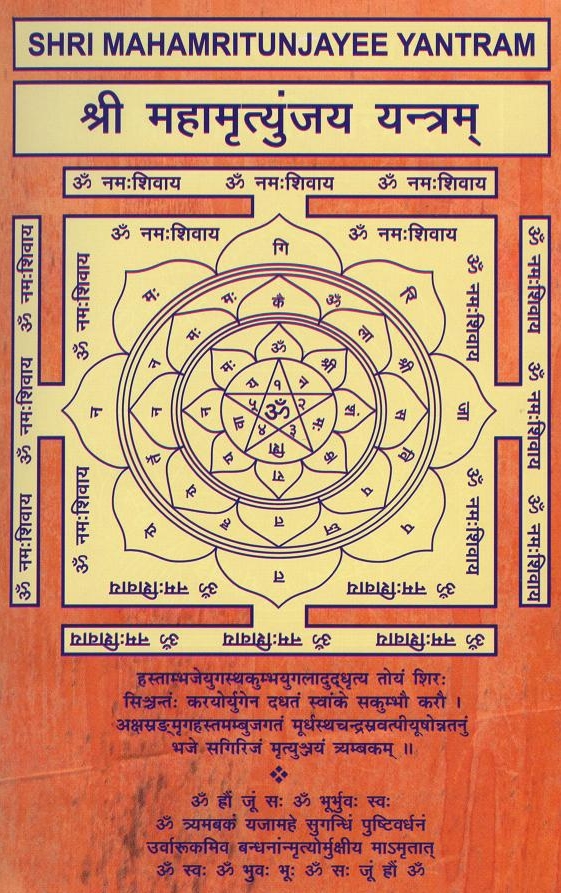
Maha Mrityunjaya Stotram
Prayer of the Great Vanquisher over Death
By Sage Markandeya
Translated by P. R. Ramachander
Translated by P. R. Ramachander
 Sage Mrukandu prayed Lord Shiva for a son. Lord Shiva asked him whether he wanted an intelligent son who will live only for 16 years or foolish son, who will live for one hundred years. The sage chose the former. A son was born to him and was named as Markandeya. This boy became a very great devotee of Lord Shiva. On his sixteenth birthday, he entered the sanctum sanctorum of the lord and embraced him. Yama, the lord of death came to take away his soul. Lord Shiva killed Yama. Then the boy Markandeya sang the following stotra. This prayer is supposed to ward of all evils, remove fear of death and realize all wishes.
Sage Mrukandu prayed Lord Shiva for a son. Lord Shiva asked him whether he wanted an intelligent son who will live only for 16 years or foolish son, who will live for one hundred years. The sage chose the former. A son was born to him and was named as Markandeya. This boy became a very great devotee of Lord Shiva. On his sixteenth birthday, he entered the sanctum sanctorum of the lord and embraced him. Yama, the lord of death came to take away his soul. Lord Shiva killed Yama. Then the boy Markandeya sang the following stotra. This prayer is supposed to ward of all evils, remove fear of death and realize all wishes.
Atha nyasam (Now the Introduction)
Om Shri Ganeshaya Nama. Om asya Shri Maha Mrityunjaya Stotram mantrasya, Shri Markandeya rishi, Anushtup chanda, Shri Mrityunjayo devatha, Gauri shakti, samastha mrityu santhyartham, sakala aiswarya prapthyartham, jape viniyoga.
Salutations to Lord Ganesha. I am chanting this Maha Mrityunjaya Stotra (Chant to win over death), which is composed by Sage Markandeya, in anushtup meter, with Mrityunjaya as God, Gauri as the strength, with a view to win over death and getting of all sorts of wealth.
Atha dhyanam (Now the prayer)
Chandrarkagni vilochanam, smita mukam,Padmadvayantha sthitam, Mudra pasa mrugakshasutra vilasath paanim Himaam suprabham,
Kotindu prakalathsudhaplutha thanum haaraathi, Bhooshojvalam,
Kantham vishwa vimohanam, pashupatim, Mrityunjayam bhavayeth. I meditate on the vanquisher of death,
Who has moon, sun and fire as eyes, Who has a smiling face,
Who sits on two lotus flowers, Whose hands shine with the sign the rope,
The deer and the garland of rudraksha, Who has the pleasant shine of the ice,
Who has a body drenched by nectar, From billions of moons,
Who ornaments himself with several garlands, Who is very handsome,
Who can attract the entire world, And who is the lord of all beings.
Jape Viniyoga (Now the chant is being started)
Rudram pashupatim sthanum neelakandam umapatim,Namami shirasa devam, kimno mrityu karishyati. 1 What can death do to the one,
Who salutes with his head that God, Who is the angry one,
Who is the lord of all beings, Who is stable,
Who has a blue neck, And who is the consort of Uma. Neelakandam kalamoortim kalagnyam kalanashanam,
Namami shirasa devam, kimno mrityu karishyati. 2 What can death do to the one,
Who salutes with his head that God, Who is having a blue neck,
Who is the form of death, Who knows paste, present and future,
And who destroyed the god of death. Neelakandam viroopaksham nirmalam neelayaprabham,
Namami shirasa devam, kimno mrityu karishyati. 3 What can death do to the one,
Who salutes with his head that God, Who has a blue neck,
Who has a different eye, Who is clean,
And who is dazzlingly bright. Vamadevam mahadevam lokanadham jagatgurum,
Namami shirasa devam , kimno mrityu karishyati. 4 What can death do to the one,
Who salutes with his head that God, Who judges according to merit,
Who is the greatest God, Who is the lord of the universe,
And who is the teacher of the world. Devadevam jaganatham devesham vrishabhadwajam,
Namami shirasa devam, kimno mrityu karishyati. 5 What can death do to the one,
Who salutes with his head that God, Who is the God of gods,
Who is the lord of the earth, Who is the god of devas,
And who has a bull flag. Traiksham chathurbhujam santham jata makuta dharanam,
Namami shirasa devam, kimno mrityu karishyati. 6 What can death do to the one,
Who salutes with his head that God, Who has three eyes,
Who has four hands, Who is peaceful,
And who wears matted hair and a crown. Bhasmoddulitha sarvangam nagabharana bhooshitam,
Namami shirasa devam, kimno mrityu karishyati. 7 What can death do to the one,
Who salutes with his head that God, Who is covered with ash,
All over his body, And who wears the serpent as an ornament. Anatham avyayam santham akshamala dharam haram,
Namami shirasa devam, kimno mrityu karishyati. 8 What can death do to the one,
Who salutes with his head that God, Who is limitless,
Who cannot be explained, Who is peaceful,
Who is the killer, And who wears the garland of eyes. Aanadam paramam nithyam kaivalya pada dhayinam,
Namami shirasa devam, kimno mrityu karishyati. 9 What can death do to the one,
Who salutes with his head that God, Who is happiness,
Who is beyond thought, Who is stable,
And who grants salvation. Ardhanaareesvaram devam parvaty prana nayakam,
Namami shirasa devam, kimno mrityu karishyati. 10 What can death do to the one,
Who salutes with his head that God, Who is the god half male half female,
And who is the darling of Parvaty. Pralaya sthithi karthaaram adhi kartharameesvaram,
Namami shirasa devam, kimno mrityu karishyati. 11 What can death do to the one,
Who salutes with his head that God, Who creates the state of deluge,
And who is the god who made the beginning. Vyomakesham viroopaksham chandrardha krutha shekaram,
Namami shirasa devam, kimno mrityu karishyati. 12 What can death do to the one,
Who salutes with his head that God, Whose hair is the sky,
Who has a different eye, And who has collected half of the moon. Gangadharam sashidharam shankaram shoolapaninam,
Namami shirasa devam, kimno mrityu karishyati. 13 What can death do to the one,
Who salutes with his head that God, Who carries the river Ganga,
Who keep moon as an ornament, Who is Lord Shankara,
And who carries a trident. Svargabhavarga datharam srushti sthithi vinashakam,
Namami shirasa devam, kimno mrityu karishyati. 14 What can death do to the one,
Who salutes with his head that God, Who grant heaven and salvation,
Who looks after creation, Upkeep and destruction. Kalpa ayur dehi mey punyam yavad ayur arogatham,
Namami shirasa devam, kimno mrityu karishyati. 15 What can death do to the one,
Who salutes with his head that God, Who can grant a life of an eon,
Who can bless you with a long life, Bereft of any sickness. Shivesanam mahadevam vamadevam sadashivam,
Namami shirasa devam, kimno mrityu karishyati. 16 What can death do to the one,
Who salutes with his head that God, Who is Shiva as well as Easwara,
Who is the great God, Who gives correct judgments,
And who is always peaceful. Utpati sthithi samhara kartara meeshvaram gurum,
Namami shirasa devam, kimno mrityu karishyati. 17 What can death do to the one,
Who salutes with his head that God, Who takes responsibility of creation,
Upkeep and destruction, And who is a great teacher. Gangadharam Mahadevam Sarva bharana bushitam,
Namami shirasa devam, kimno mrityu karishyati. 18 What can death do to the one,
Who salutes with his head that God, Who holds the holy river Ganga,
The Supreme Lord, Who has poisonous serpents as ornaments. Anatha paramanandam Kaivalya pradagaminam,
Namami shirasa devam, kimno mrityu karishyati. 19 What can death do to the one,
Who salutes with his head that God, Who is primordial,
Who is nature is of Supreme bliss, Who bestows Salvation. Markandeya kritnam Stotram ya padeth Shiva sannidhou,
Thasya mrityu bhayam nasthi nagni chora bhayam kvachiti. 20 Anyone reading this prayer,
Written by Markandeya In front of Lord Shiva,
Would not have fear of death, Nor fear of fire and thieves. Shatavratam prakarthavyam sankate kashta nashanam,
Suchir bhoothva pathe Stotram sharva sidhi pradhayakam. 21 Reading it one hundred times
In times of misery, Will get rid of it,
And reading it with a clean mind Would make one get all his wants. Mrithyunjaya Mahadeva thrahi maam sharanagatam,
Janma mrityu jadharogehi, peeditam karma bandhanehi. 22 Oh great God, who has won over god of death,
Please save me as I am submitting to you, From births, deaths, old age and diseases,
And also the ties of karma, which affect me. Thaavaka stvad gatha prana thawa chithoham sada mruda,
Ithi vignapya devesam thryambakakhyam japeth. 23 I appeal to the God:
My soul goes towards you, And my mind always meditates on you,
And then chant of Trayambaka Mantra*. Namah shivaya Sambaya haraye paramatmane,
Pranata klesha nashaya yoginam pataye namaha. 24 I salute that Samba,
Who is the inner soul of the destroyer, And pray - destroy all life's problems,
Oh Lord of Yoga, I salute you. Iti Shri Markandeya purane Markandeya krita
Maha Mrityunjaya Stotram sampurnam. Thus ends in the Sacred Markandeya Purana the Maha Mrityunjaya Stotra
which written by sage Markandeya.
* Trayambaka Mantra also known as Maha Mrityunjaya Mantra is a verse of the Yajurveda. It is in Rudram and it is as follows:
ॐ त्र्यम्बकं यजामहे सुगन्धिं पुष्टिवर्धनम् |
उर्वारुकमिव बन्धनान् मृत्योर्मुक्षीय मामृतात् ||
Om tryambakam yajamahe sugandhim pushti vardhanam |
Om tryambakam yajamahe sugandhim pushti vardhanam |
Urvarukamiv bandhnan mrityormokshiya maamritaat ||
Maha Mrityunjaya Kavacham
Kavacham mean a shield. When a Kavacham is sung, it is to specified Lord to request that he act as our shield and protect us against all external and internal enemies. Maha Mrityunjaya Kavacham is one of the most powerful Kavacham, which is believed to be spiritually capable in bringing back a person in normal life from a life threatening situation. This Kavacham rejuvenates the vitality of a person who is even in a death bed by becoming the victim of some diseases or accident and may saves his / her life.

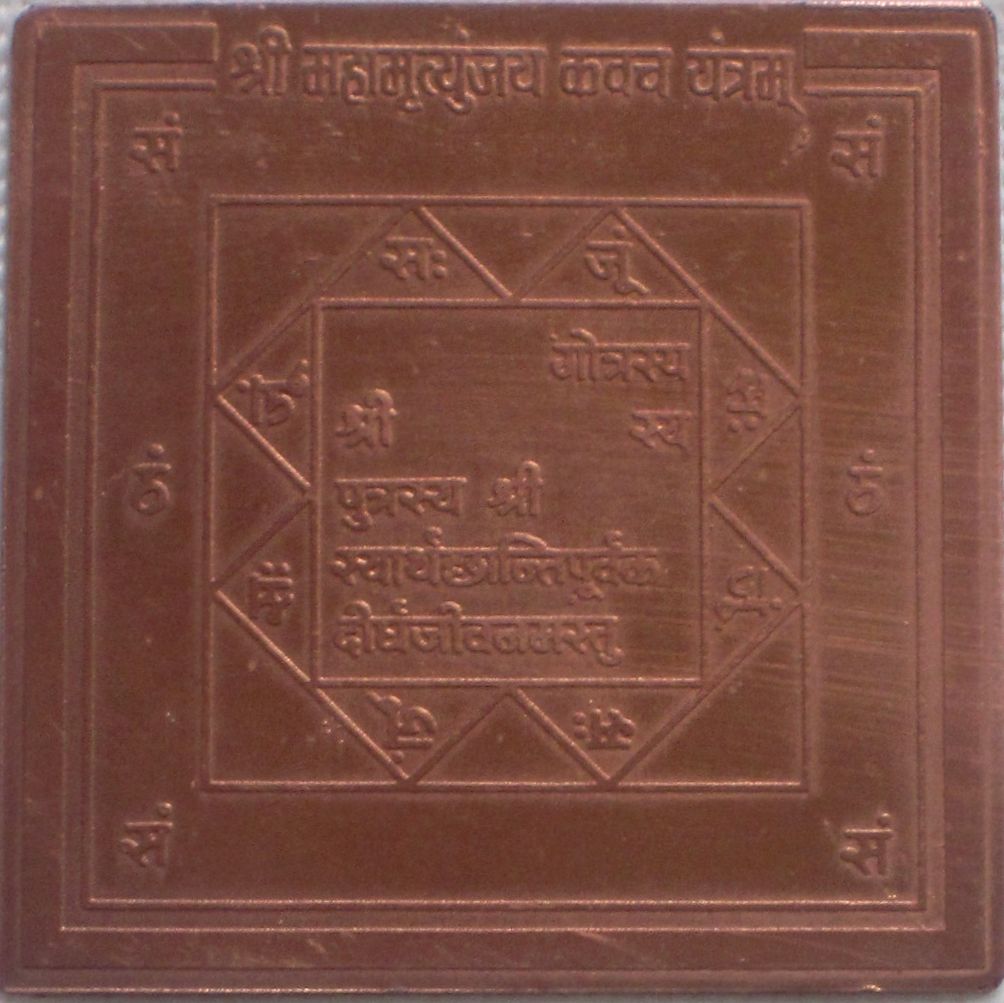
Maha Mrityunjaya Homam
The Maha Mrityunjaya Homam is performed to achieve Jaya or Victory over Mrityu or death. The object of worship of this homa is Lord Shiva. One of the synonyms of Lord Shiva is Mrityu. Mrityu which means death of the death or the destroyer of death. During this homa one chants 21 mantras. The prominent offerings in this homa are durva grass and an herb called amrita. The former is famous for purifying blood and the latter is used as a medicine for incurable diseases like arbuda or cancer. Since these are used as offerings in this homa, it is believed that this homam bestows longevity on the performer. The hymns are devoted to Mrityu, the God of death, praying for long life. These hymns are used in the purnahuti or the final offering in the famous Soma sacrifice. This homa also alleviates Mrityu dosha or untimely death.
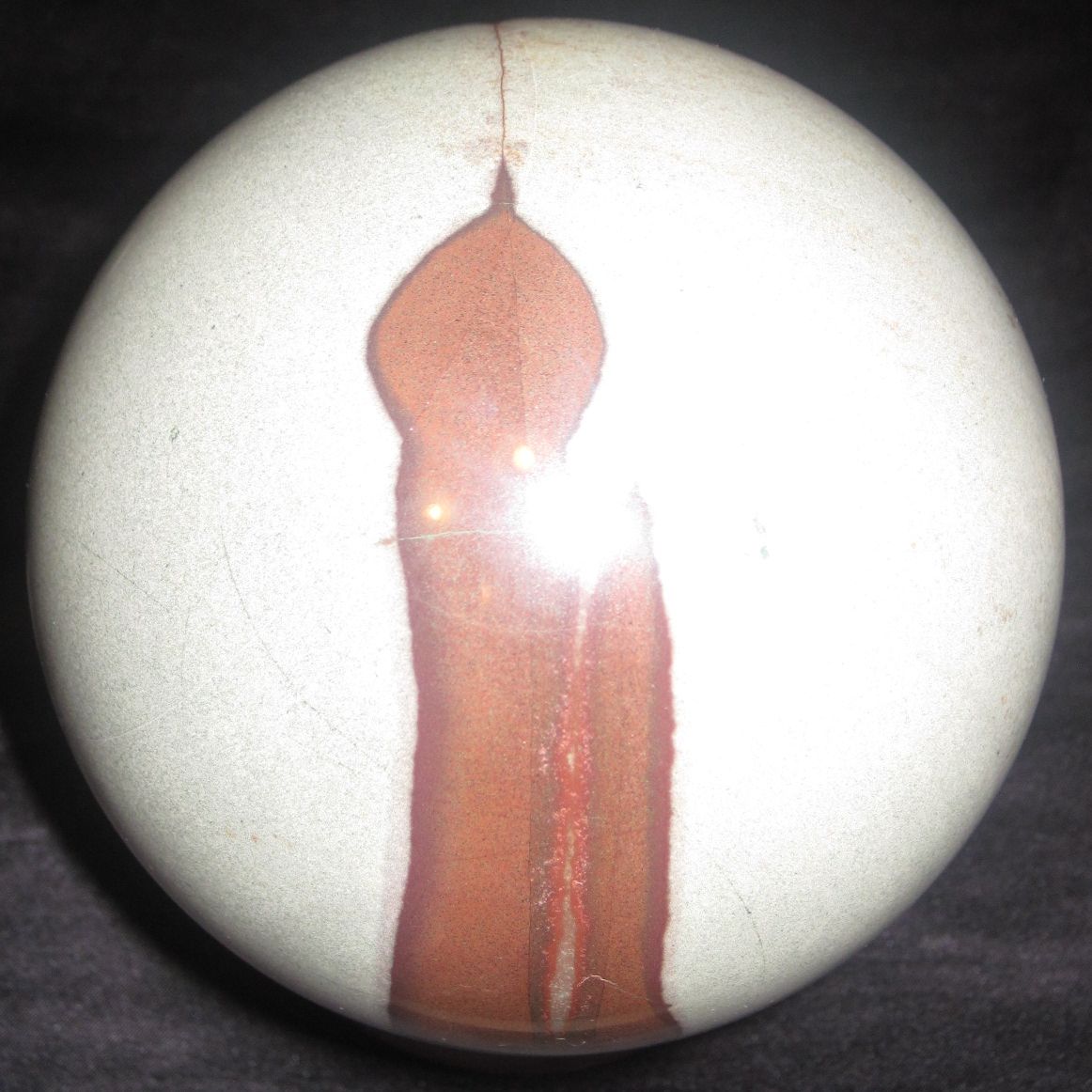 Maha Mrityunjaya Homa Mantra
tryambakam yajamahe sugandhim pushtivardhanam
Maha Mrityunjaya Homa Mantra
tryambakam yajamahe sugandhim pushtivardhanam
om hoom joom sah ma mrityor palaya palaya roha mochaya mochaya ayurvardhaya vardhaya
sah joom hoom om urvarukamiva bandhanaan mrityor muksheeya maamritaate
mrityunjayaya rudraya neelakanthaya sambhave amriteshaya sarvaya mahadevayadhe namaha svaha